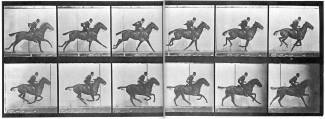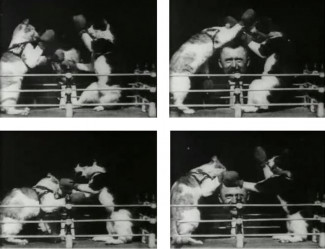
Johns Hopkins UniversityEst. 1876
America’s First Research University
Galloping horses to boxing cats: Movies in Education

There was a great debate among horsemen in the mid-19th century, as to whether or not all four of a horse’s legs were lifted off the ground at the same time they were galloping. The action happened so fast that it was impossible to see the truth with the naked eye, and people from all walks of life had strong opinions for and against what they termed “unsupported transit.” Railroad magnate Leland Stanford- former Governor of California and future benefactor of the university that bears his name, took a strong stance that unsupported transit did indeed occur, and put his entrepreneurial verve to try and prove it.
He hired the famous early photographer Edward Muybridge to settle the question using the newly emerging field of photography, hoping to be able to record an image of all four legs of the horse off the ground. On June 15, 1878, Muybridge invited members of the press to watch Stanford’s horse trot across the set he had prepared and trigger each of the 12 cameras, one after another, provided a dozen perfectly crisp images of the horse in motion-- one which showed the equine with all four feet clearly in the air.
The idea that motion in the world could be captured and replayed at any point was as transcendental as photography had been a mere 50 years earlier. Before photography emerged in the early 19th century, visual representations of the world were mediated by artists, who consciously chose what and how to depict them. Photography shortened that interpretive chain by using technology, and Muybridge’s application of photography to capture motion paved the way for these slices of time to be combined so as to reconstruct the motion they discretely captured.

Muybridge promoted his Zoopraxiscope to thrilled audiences across the country, including one stop Orange, New Jersey, the hometown of Thomas Edison. America’s most prolific inventor reportedly attended the lecture and soon embarked on an ambitious effort to commercialize the idea of moving picture by invented new technology to record and display short sequences.
Edison built the first motion-picture studio in 1893 and brought in performers, including scenes that were off-color for the era: scantily-clad women dancing, boxing matches, cockfights, and even performers from Buffalo Bill's Wild West Show. And just to prove the historical precedence of Internet cat videos, there was Professor Welton's Boxing Cats (Google “boxing cats” see the actual movie).

The Khan Academy is perhaps the most well-known provider of instructional videos online. The nonprofit company was founded in 2008 by Salman Khan, who gave up his lucrative day job at a hedge fund to produce short educational videos hosted on YouTube to help tutor students in subjects such as algebra. Khan came to instruction through the back door. While attending a family wedding, he happened to talk with his 12-year old cousin, who was struggling with math.
It was clear to Khan that Nadia was bright and motivated, but she needed some one-on-one help, and he offered to tutor her remotely from his home in Boston. They used the telephone and a drawing program that allowed them to draw freehand on the same virtual screen, some 1,500 miles apart. Those tutoring sessions provided a working laboratory for Khan to work out some of the ideas that would ultimately form his now-famous instructional video lessons.
By 2006, Khan was tutoring a number of his family members, but found the logistics of scheduling the synchronous phone meetings difficult. A friend suggested he use Google's new video sharing service YouTube to host his videos among the piano-playing cat video. At the time YouTube limited the length of videos to only 10 minutes, but this turned out to be the ideal length for a single learning session, as later suggested by cognitive researchers. He wrote some simple math quizzing software, and the bones of the Khan Academy were formed.
To date, the Khan Academy has served over 600 million of these lessons, ranging from basic math to physics, biology, economics, computer science and more. The site is used by over one million teachers who assign the videos to augment classroom activities, and provide remedial instruction.
Bill Ferster is a research professor at the University of Virginia’s Curry School of Education and the director of visualization for the Sciences, Humanities & Arts Technology Initiative (SHANTI). He is the author of Teaching Machines: Learning from the Intersection of Education and Technology, and most recently, Sage on Screen: Education, Media, and How We Learn.
[i] Smith, F. (July 9, 1913). The evolution of the motion picture: VI- Looking into the future with Thomas A. Edison. New York Dramatic Mirror, p. 24.


